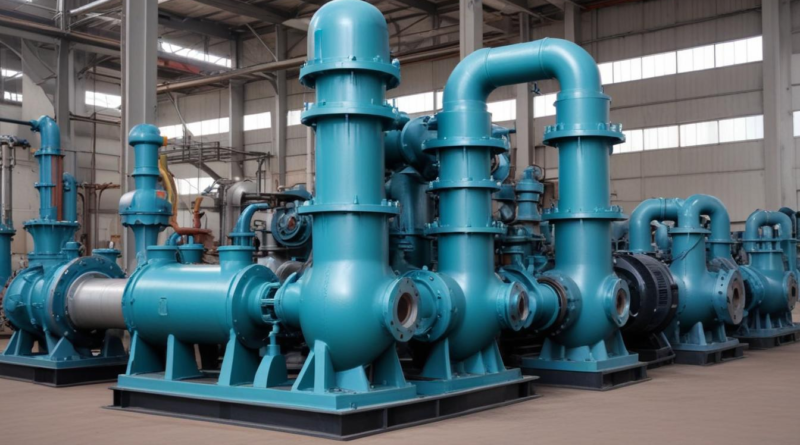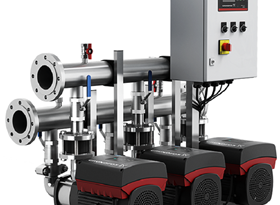the role of pumps in industrial blending
In industrial blending applications, selecting the appropriate pump type is crucial to ensure optimal performance and consistency. Various industrial blending pumps are employed, each offering unique functionality to cater to specific blending requirements.
- Centrifugal Pumps: Ideal for low to medium viscosity fluids, centrifugal pumps utilize rotational energy to move liquids. They are favored for their simplicity and ability to handle large flow rates, making them suitable for blending water-based solutions and other homogeneous mixtures.
- Positive Displacement Pumps: These pumps are essential when precise dosing and handling of high-viscosity fluids are required. Types include gear pumps, diaphragm pumps, and piston pumps, each providing consistent flow rates regardless of pressure fluctuations, which is vital for maintaining blend uniformity.
- Peristaltic Pumps: Operating through the compression and release of a flexible tube, peristaltic pumps offer excellent control over flow rates and are particularly useful for sensitive or shear-sensitive materials. Their ability to prevent contamination makes them ideal for pharmaceutical and food-grade blending processes.
- Gear Pumps: A subset of positive displacement pumps, gear pumps are renowned for their durability and ability to handle thick, abrasive materials. They ensure a steady flow, which is critical for maintaining the consistency of the blended product.
- Screw Pumps: Utilizing one or multiple screws to move fluids, screw pumps are effective for handling high-viscosity liquids and slurries. Their gentle pumping action minimizes shear, preserving the integrity of delicate components within the blend.
| Pump Type | Key Features | Applications |
|---|---|---|
| Centrifugal Pumps | High flow rates, low suction heads | Water-based blending, large volume mixing |
| Positive Displacement Pumps | Precise dosing, handles high viscosity | Chemical blending, viscous liquid processing |
| Peristaltic Pumps | Contamination-free, precise control | Pharmaceuticals, food-grade applications |
| Gear Pumps | Durable, steady flow | Abrasive material handling, consistent blending |
| Screw Pumps | Gentle pumping action, high viscosity | Slurry mixing, delicate ingredient blending |
Each pump type plays a distinct role in the blending process, and understanding their specific functionality ensures the selection of the most appropriate pump for the desired application. This tailored approach enhances the efficiency and quality of the industrial blending operations.
pump selection criteria
Selecting the appropriate pump for industrial blending applications involves a comprehensive evaluation of several critical factors to ensure optimal performance and reliability. The following criteria play a pivotal role in guiding the selection process:
- Flow Rate and Capacity: Determining the required flow rate is essential to meet production demands. It is important to assess both the minimum and maximum flow rates needed for the blending process to maintain consistency and efficiency.
- Viscosity of Materials: The viscosity of the fluids being blended greatly influences the type of pump selected. High-viscosity materials may necessitate the use of positive displacement pumps, which can handle thicker substances more effectively than centrifugal pumps.
- Chemical Compatibility: Ensuring that the pump materials are compatible with the chemicals being processed is crucial to prevent corrosion, degradation, and contamination. Selecting pumps with appropriate seals and construction materials extends their longevity and maintains product integrity.
- Temperature Range: The operating temperature of the blending process can impact pump performance. It is vital to choose pumps that can operate efficiently within the specific temperature ranges required, whether dealing with cryogenic fluids or high-temperature solutions.
- Pressure Requirements: Understanding the pressure conditions of the blending system is necessary to select a pump that can handle the required pressure without compromising functionality or safety.
- Energy Efficiency: Evaluating the energy consumption of potential pumps helps in selecting models that offer high efficiency, reducing operational costs and minimizing environmental impact.
- Maintenance and Reliability: Pumps should be chosen based on their ease of maintenance and their track record for reliability. Industrial blending pumps with modular designs and readily available spare parts can significantly reduce downtime and maintenance costs.
- Hygienic Design: For applications in the pharmaceutical and food industries, pumps with hygienic designs that comply with industry standards are essential to prevent contamination and ensure product safety.
- Control and Automation Capabilities: Modern blending operations often require precise control and integration with automated systems. Pumps equipped with advanced control features and compatibility with industrial automation protocols enhance the overall efficiency and flexibility of the blending process.
To further illustrate how these criteria influence pump selection, the following table outlines the alignment of specific requirements with suitable pump types:
| Selection Criterion | Considerations | Suitable Pump Types |
|---|---|---|
| Flow Rate and Capacity | High flow rates needed | Centrifugal Pumps, Screw Pumps |
| Viscosity of Materials | High viscosity fluids | Positive Displacement Pumps, Gear Pumps |
| Chemical Compatibility | Abrasive or corrosive chemicals | Diaphragm Pumps, Peristaltic Pumps |
| Temperature Range | Extreme temperatures | Specialized Centrifugal Pumps, Stainless Steel Pump Options |
| Pressure Requirements | High-pressure systems | Positive Displacement Pumps, High-Pressure Centrifugal Pumps |
| Energy Efficiency | Low energy consumption | Variable Speed Drives on Centrifugal Pumps, Energy-Efficient Positive Displacement Pumps |
| Maintenance and Reliability | Minimal downtime | Modular Design Pumps, Self-priming Centrifugal Pumps |
| Hygienic Design | Food-grade or pharmaceutical standards | Sanitary Centrifugal Pumps, Peristaltic Pumps |
| Control and Automation | Integration with automated systems | Smart Pumps with PLC Integration, IoT-Enabled Pump Models |
By meticulously evaluating each of these selection criteria, industries can ensure that the chosen industrial blending pumps align with their specific functionality requirements and operational demands. This strategic approach not only optimizes the blending process but also enhances overall system performance and longevity.
maintenance and reliability
Ensuring the optimal performance and longevity of pumps in industrial blending applications hinges on effective maintenance strategies and a focus on reliability. Regular maintenance not only prevents unexpected downtimes but also sustains the consistent functionality required for high-quality blending processes. Key aspects to consider include:
- Scheduled Maintenance: Implementing a routine maintenance schedule is essential for early detection of potential issues. This includes regular inspections, lubrication of moving parts, and timely replacement of wear components such as seals, bearings, and impellers.
- Condition Monitoring: Utilizing condition monitoring techniques, such as vibration analysis, thermal imaging, and acoustic inspections, allows for the assessment of pump health in real-time. These methods help identify anomalies that may indicate impending failures, enabling proactive maintenance actions.
- Preventive Maintenance: Adopting a preventive maintenance approach helps mitigate the risk of pump failures. This involves performing maintenance tasks based on manufacturer recommendations and operational experience, rather than waiting for issues to arise.
- Training and Expertise: Ensuring that maintenance personnel are adequately trained and knowledgeable about the specific types of industrial blending pumps in use is crucial. Skilled technicians can effectively perform maintenance tasks, troubleshoot problems, and implement repairs, thereby enhancing overall reliability.
- Spare Parts Management: Maintaining an inventory of critical spare parts minimizes downtime during repairs. Rapid access to replacement components ensures that maintenance activities can be conducted promptly, sustaining the blending process without significant interruptions.
- Documentation and Record-Keeping: Keeping detailed records of maintenance activities, including inspections, repairs, and part replacements, provides valuable insights into pump performance trends. This historical data aids in refining maintenance schedules and improving reliability over time.
Reliability of industrial blending pumps is influenced by several factors, including pump design, quality of components, and operational conditions. Selecting pumps from reputable manufacturers who prioritize durability and reliability can substantially reduce the frequency of maintenance interventions. Additionally, ensuring that pumps are operated within their specified parameters prevents undue stress and premature wear, further enhancing their lifespan.
| Maintenance Aspect | Best Practices | Benefits |
|---|---|---|
| Scheduled Maintenance | Regular inspections and part replacements based on a maintenance calendar | Prevents unexpected failures, extends pump life |
| Condition Monitoring | Use of vibration analysis and thermal imaging | Early detection of issues, reduces downtime |
| Preventive Maintenance | Maintenance tasks based on usage and manufacturer guidelines | Enhances reliability, ensures consistent performance |
| Training and Expertise | Regular training programs for maintenance staff | Improves maintenance quality, reduces error rates |
| Spare Parts Management | Maintain inventory of critical spare parts | Minimizes downtime, ensures quick repairs |
| Documentation and Record-Keeping | Detailed logs of all maintenance activities | Informs maintenance planning, tracks performance trends |
Incorporating these maintenance and reliability practices ensures that the industrial blending pumps continue to perform effectively, supporting the seamless operation of blending processes. A strategic focus on maintenance not only safeguards the functionality of the pumps but also contributes to the overall efficiency and quality of the industrial blending system.
efficiency and energy considerations
 Energy consumption and efficiency are pivotal factors in the operation of industrial blending systems, directly influencing both operational costs and environmental sustainability. Optimizing the energy efficiency of pumps not only reduces energy expenditure but also minimizes the carbon footprint associated with industrial blending processes. Several strategies and considerations play a crucial role in enhancing the efficiency and energy performance of these systems:
Energy consumption and efficiency are pivotal factors in the operation of industrial blending systems, directly influencing both operational costs and environmental sustainability. Optimizing the energy efficiency of pumps not only reduces energy expenditure but also minimizes the carbon footprint associated with industrial blending processes. Several strategies and considerations play a crucial role in enhancing the efficiency and energy performance of these systems:
- Proper Pump Sizing: Selecting a pump that matches the required flow rate and pressure is fundamental to achieving high efficiency. Oversized pumps can lead to unnecessary energy consumption, while undersized pumps may struggle to maintain desired performance levels, resulting in increased wear and tear.
- Variable Speed Drives (VSDs): Implementing VSDs allows for the adjustment of pump speed to match the varying demands of the blending process. This adaptability ensures that energy is not wasted by running pumps at full speed when lower flow rates are sufficient, thereby enhancing overall energy efficiency.
- High-Efficiency Motors: Utilizing motors with higher efficiency ratings reduces the electrical energy required to drive the pumps. Investing in premium motors can lead to significant energy savings over the lifespan of the pump system.
- System Design Optimization: Designing the blending system to minimize friction losses and ensure smooth fluid flow can substantially improve pump efficiency. This includes selecting appropriate pipe sizes, reducing bends and fittings, and ensuring proper alignment of pump components.
- Regular Maintenance: Maintaining pumps in optimal condition through routine inspections and timely repairs prevents efficiency degradation caused by wear, fouling, or mechanical issues. Clean and well-lubricated pumps operate more efficiently and consume less energy.
- Advanced Control Systems: Integrating smart control systems that monitor and adjust pump operations in real-time can optimize energy usage. These systems can predict demand fluctuations and adjust pump parameters accordingly, ensuring efficient operation under varying conditions.
Implementing these strategies can lead to significant improvements in both the efficiency and energy consumption of industrial blending pumps. The following table outlines common efficiency enhancement techniques and their respective benefits:
| Efficiency Enhancement Technique | Description | Benefits |
|---|---|---|
| Proper Pump Sizing | Selecting a pump that precisely matches the process requirements | Reduces energy waste, minimizes wear, and extends pump lifespan |
| Variable Speed Drives (VSDs) | Adjusting pump speed based on real-time demand | Enhances energy savings, provides operational flexibility |
| High-Efficiency Motors | Using motors with superior energy efficiency ratings | Decreases electrical consumption, lowers operational costs |
| System Design Optimization | Minimizing friction and ensuring optimal fluid flow | Improves pump performance, reduces energy requirements |
| Regular Maintenance | Conducting routine inspections and maintenance tasks | Prevents efficiency loss, avoids unexpected downtimes |
| Advanced Control Systems | Integrating smart monitoring and control technologies | Optimizes energy usage, enhances system responsiveness |
Energy Efficiency Metrics are essential for assessing and benchmarking the performance of industrial blending pumps. Key metrics include:
- Pump Efficiency: Defined as the ratio of the hydraulic power delivered by the pump to the electrical power consumed. Higher efficiency indicates better performance and lower energy consumption.
- Affinity Laws: Mathematical relationships that describe how changes in pump speed affect flow rate, head, and power consumption. Understanding these laws helps in predicting the impact of speed adjustments on energy usage.
- Total Energy Consumption: The overall energy used by the pump system over a given period. Monitoring this metric helps identify opportunities for energy savings and system optimization.
Optimizing energy efficiency also involves evaluating the functionality of the pump within the broader blending system. Ensuring that pumps operate at their peak efficiency during critical blending stages enhances the overall performance and quality of the blended product. Additionally, energy-efficient pumps contribute to the sustainability goals of industrial operations by reducing greenhouse gas emissions and supporting energy conservation initiatives.
Implementing energy-efficient technologies and practices in pump systems not only yields cost savings but also aligns with global efforts to promote sustainable industrial practices. As industries continue to seek ways to enhance operational efficiency and reduce environmental impact, the role of pumps in achieving these objectives becomes increasingly significant.
case studies in industrial blending
In the realm of industrial blending, real-world applications underscore the critical role that pumps play in ensuring efficiency, consistency, and product quality. The following case studies illustrate how different industries leverage industrial blending pumps to overcome specific challenges and achieve their operational objectives.
Case Study 1: Pharmaceutical Active Ingredient Blending
A leading pharmaceutical manufacturer faced challenges in blending high-viscosity active pharmaceutical ingredients (APIs) with precise dosing requirements. The existing blending system struggled to maintain uniformity, leading to inconsistencies in product batches.
Challenges:
– Handling highly viscous APIs without degrading their integrity.
– Ensuring precise and consistent dosing to meet stringent regulatory standards.
– Preventing contamination in a highly controlled manufacturing environment.
Solution:
The manufacturer implemented positive displacement pumps, specifically diaphragm pumps, to handle the viscous APIs. These pumps provided the necessary control and consistency in dosing, while their contamination-free design met the stringent hygienic standards of pharmaceutical production.
Results:
– Achieved uniform blending of APIs, enhancing product consistency.
– Reduced contamination risks, ensuring compliance with regulatory standards.
– Increased operational efficiency by minimizing downtime and maintenance requirements.
Case Study 2: Food Industry Sauce Production
A prominent food processing company specialized in producing a variety of sauces encountered issues with pump selection that could handle thick, shear-sensitive ingredients without compromising product quality.
Challenges:
– Blending thick sauces without introducing shear that could alter texture and flavor.
– Maintaining a steady flow rate to ensure consistent product quality.
– Ensuring easy cleanability to adhere to food safety standards.
Solution:
The company adopted peristaltic pumps for their blending operations. These pumps facilitated gentle handling of shear-sensitive ingredients, provided precise flow control, and offered easy maintenance and cleaning, aligning with food safety requirements.
Results:
– Preserved the integrity and quality of delicate sauce formulations.
– Improved consistency in product batches, enhancing customer satisfaction.
– Streamlined cleaning processes, reducing downtime between production runs.
Case Study 3: Chemical Industry Corrosive Material Blending
A chemical manufacturing firm needed to blend highly corrosive liquids accurately and safely. The existing pump systems were prone to corrosion, leading to frequent maintenance and potential safety hazards.
Challenges:
– Handling highly corrosive materials without degrading pump components.
– Ensuring accurate blending to meet chemical specifications.
– Enhancing system reliability to prevent safety incidents.
Solution:
The firm integrated peristaltic pumps equipped with chemically resistant tubing and stainless steel components. These pumps provided reliable performance when handling aggressive chemicals and allowed for precise blending necessary for chemical formulations.
Results:
– Enhanced durability and lifespan of pump systems due to corrosion-resistant materials.
– Improved accuracy in blending, ensuring consistent chemical compositions.
– Increased safety and reduced maintenance costs by minimizing pump failures.
The following table summarizes the key aspects of these case studies:
| Industry | Challenge | Solution | Outcome |
|---|---|---|---|
| Pharmaceutical | Blending high-viscosity APIs with precise dosing | Implemented positive displacement diaphragm pumps | Achieved uniform blending, reduced contamination, increased efficiency |
| Food Processing | Blending thick, shear-sensitive sauces | Adopted peristaltic pumps | Preserved product integrity, improved consistency, streamlined cleaning |
| Chemical Manufacturing | Handling highly corrosive liquids | Integrated chemically resistant peristaltic pumps | Enhanced pump durability, improved blending accuracy, increased safety |
These case studies demonstrate the functionality and versatility of industrial blending pumps across various sectors. By selecting the appropriate pump types tailored to specific application requirements, industries can effectively address their unique blending challenges, ensuring operational excellence and product quality.




